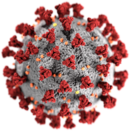Wikipedia:Today's featured article/March 27, 2020

A virus is an infectious agent that reproduces inside the cells of living hosts. Unlike most living things, viruses do not have cells that divide; instead they force infected host cells to produce thousands of identical copies of the original virus, at an extraordinary rate. A virus consists of two or three parts: genes, made from either DNA or RNA, long molecules that carry the genetic information; a protein coat that protects the genes; and in some, an envelope of fat that surrounds and protects them when they are not contained within a host cell (and makes them vulnerable to soap). Viruses spread in different ways; some through the air by people when they cough or sneeze, others by the faecal–oral route, and some by direct contact or during sex. Over 4,800 species have been discovered, many of which cause disease in plants and animals, including common human diseases such as the common cold, chickenpox and cold sores, and serious epidemics and pandemics such as HIV/AIDS, Ebola, influenza, SARS and COVID-19. (Full article...)
